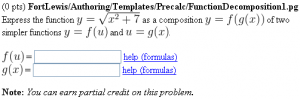FunctionDecomposition1: Difference between revisions
Jump to navigation
Jump to search
No edit summary |
No edit summary |
||
| Line 1: | Line 1: | ||
<h2>Function Decomposition</h2> | <h2>Function Decomposition</h2> | ||
[[File:FunctionDecomposition1.png|300px|thumb|right|Click to enlarge]] | |||
<p style="background-color:#eeeeee;border:black solid 1px;padding:3px;"> | <p style="background-color:#eeeeee;border:black solid 1px;padding:3px;"> | ||
This PG code shows how to check student answers that are a composition of functions. | This PG code shows how to check student answers that are a composition of functions. | ||
</p> | </p> | ||
* Download file: [[File:FunctionDecomposition1.txt]] (change the file extension from txt to pg when you save it) | |||
* File location in NPL: <code>FortLewis/Authoring/Templates/Precalc/FunctionDecomposition1.pg</code> | |||
<br clear="all" /> | |||
<p style="text-align:center;"> | <p style="text-align:center;"> | ||
[[SubjectAreaTemplates|Templates by Subject Area]] | [[SubjectAreaTemplates|Templates by Subject Area]] | ||
Revision as of 20:28, 2 December 2010
Function Decomposition

This PG code shows how to check student answers that are a composition of functions.
- Download file: File:FunctionDecomposition1.txt (change the file extension from txt to pg when you save it)
- File location in NPL:
FortLewis/Authoring/Templates/Precalc/FunctionDecomposition1.pg
| PG problem file | Explanation |
|---|---|
|
Problem tagging: |
|
DOCUMENT(); loadMacros( "PGstandard.pl", "MathObjects.pl", "answerComposition.pl", "AnswerFormatHelp.pl", ); TEXT(beginproblem()); |
Initialization:
We need to include the macros file |
Context("Numeric");
Context()->variables->add(u=>"Real");
$a = random(2,9,1);
$f = Formula("sqrt(u)");
$g = Formula("x^2+$a");
|
Setup: |
Context()->texStrings;
BEGIN_TEXT
Express the function \( y = \sqrt{ x^2 + $a } \)
as a composition \( y = f(g(x)) \) of two simpler
functions \( y = f(u) \) and \( u = g(x) \).
$BR
$BR
\( f(u) \) = \{ ans_rule(20) \}
\{ AnswerFormatHelp("formulas") \}
$BR
\( g(x) \) = \{ ans_rule(20) \}
\{ AnswerFormatHelp("formulas") \}
END_TEXT
Context()->normalStrings;
|
Main Text: |
$showPartialCorrectAnswers = 1; COMPOSITION_ANS( $f, $g, vars=>['u','x'], showVariableHints=>1); |
Answer Evaluation:
We use the |
Context()->texStrings;
BEGIN_SOLUTION
${PAR}SOLUTION:${PAR}
Solution explanation goes here.
END_SOLUTION
Context()->normalStrings;
COMMENT('MathObject version.');
ENDDOCUMENT();
|
Solution: |